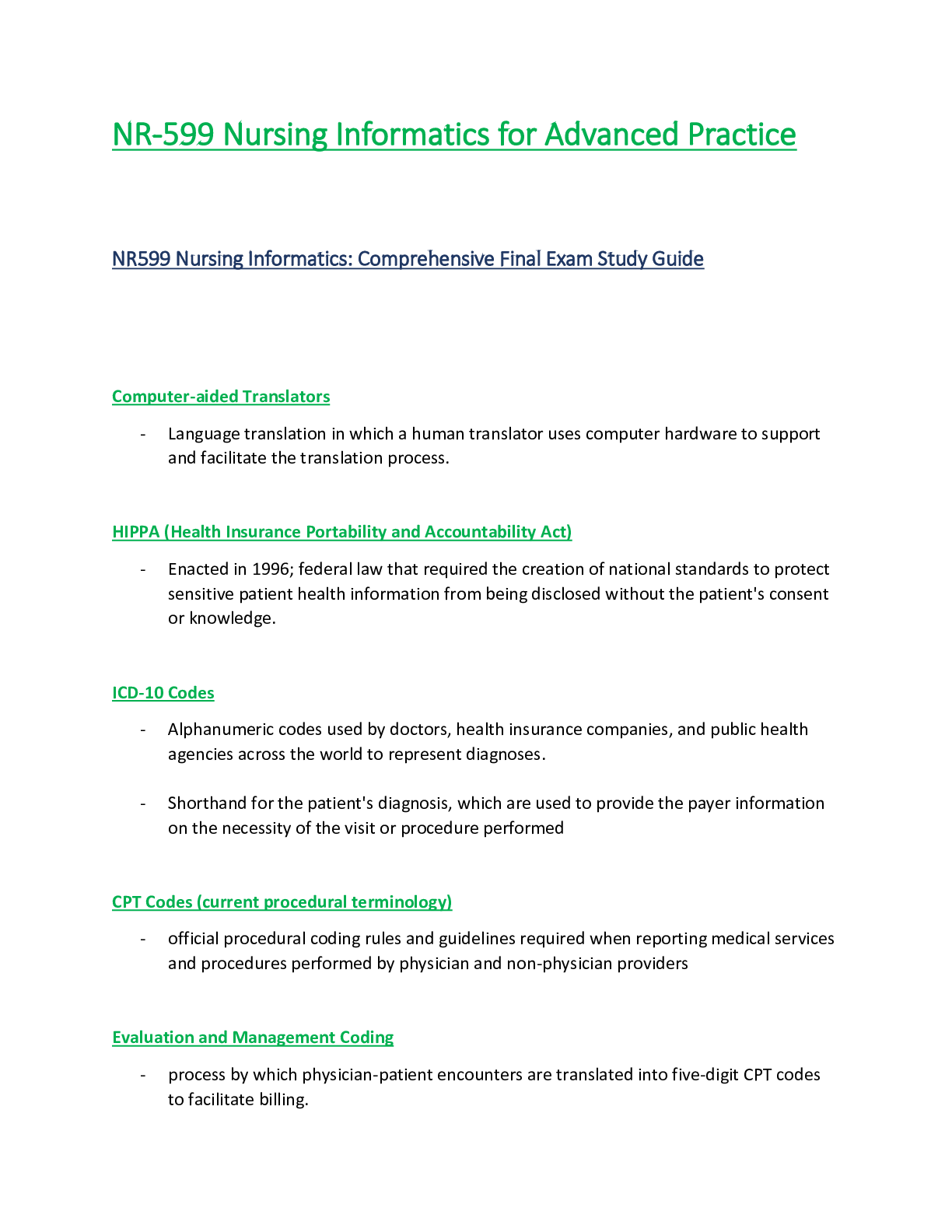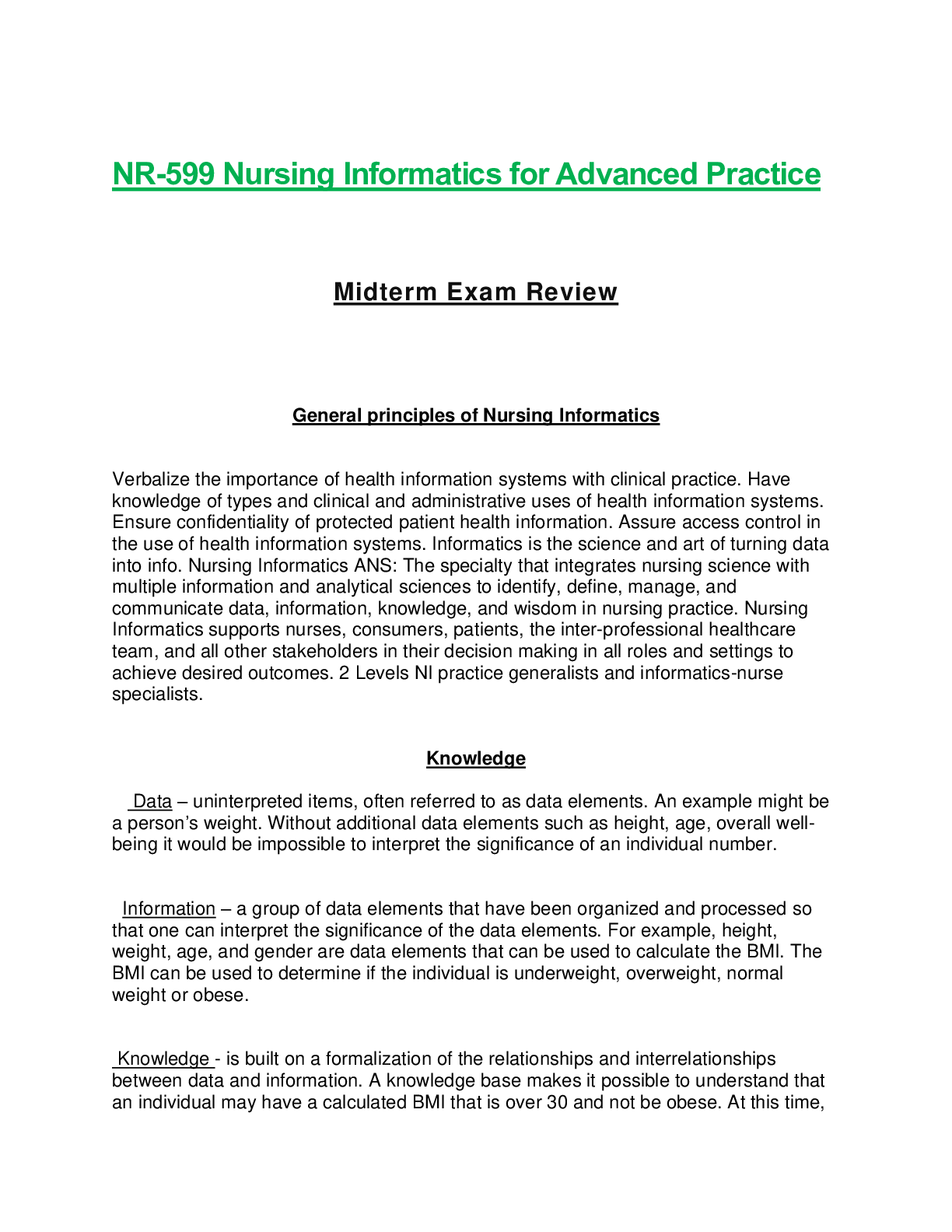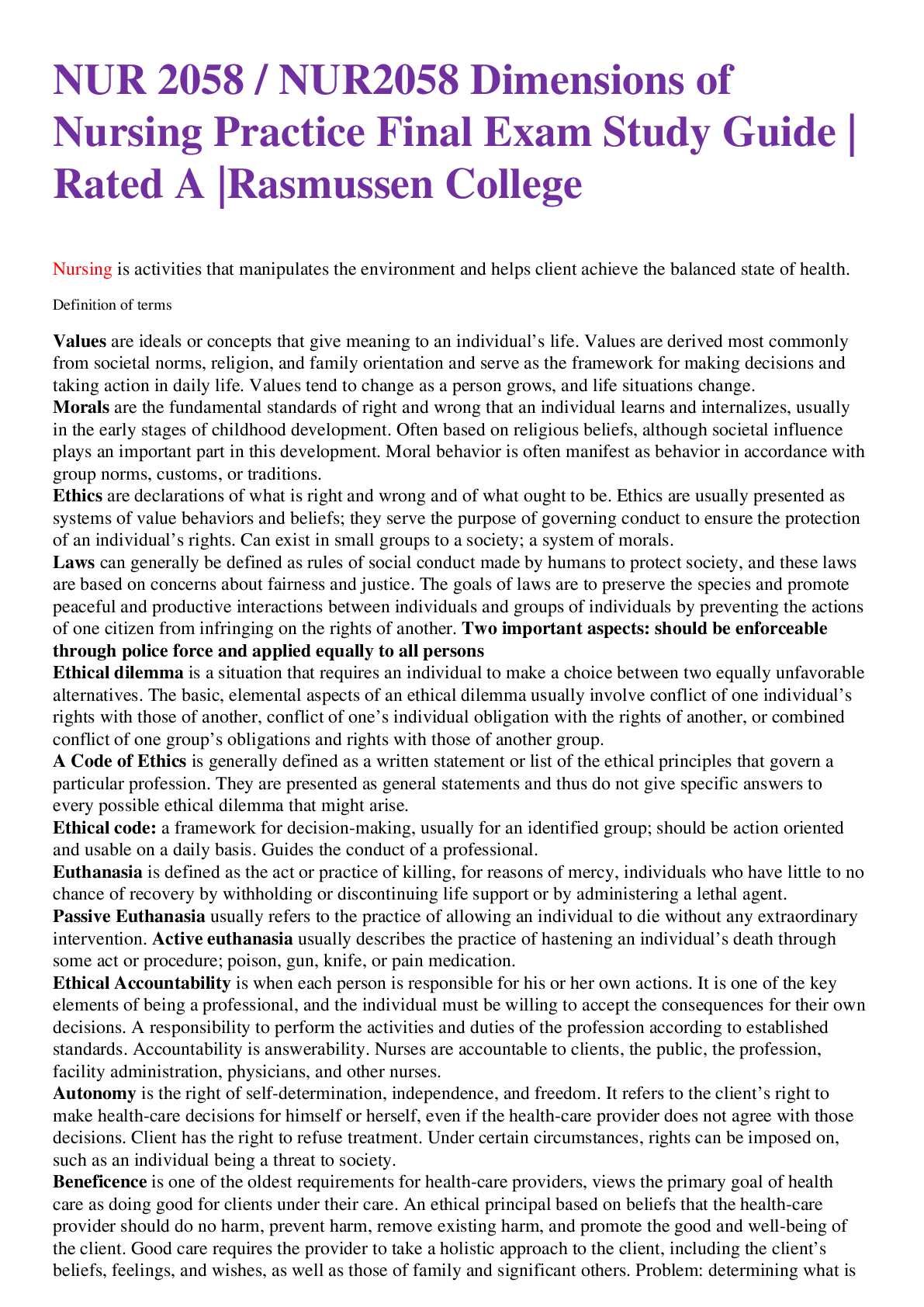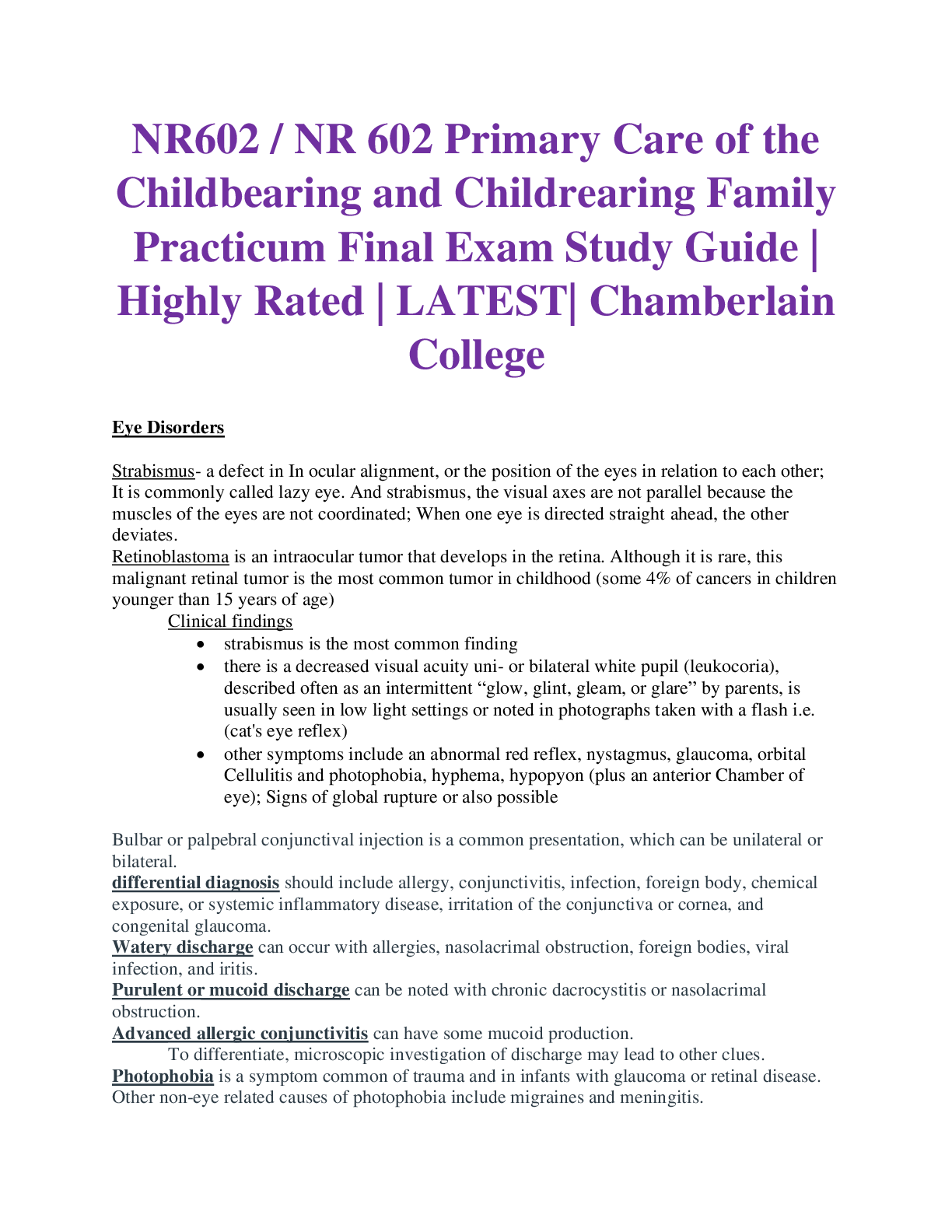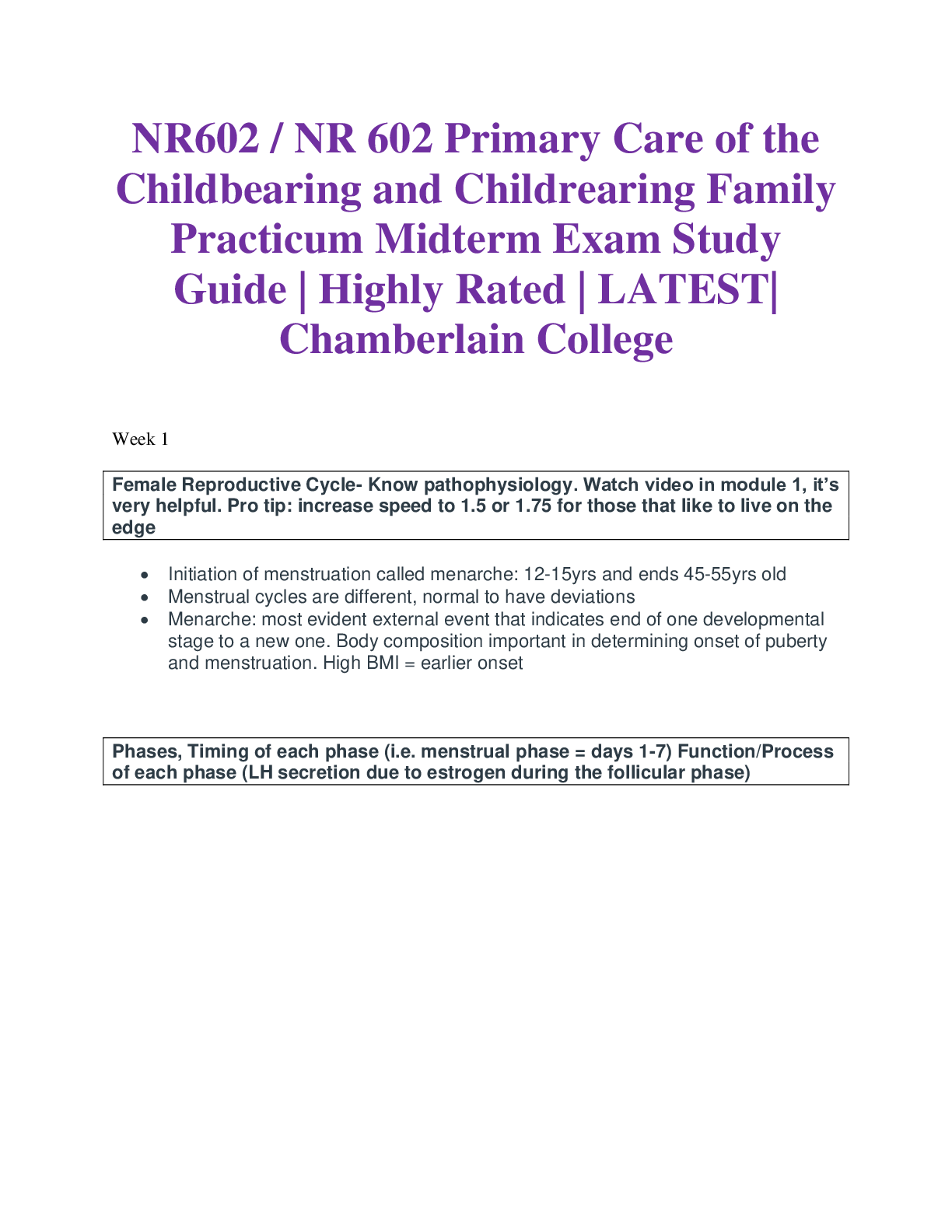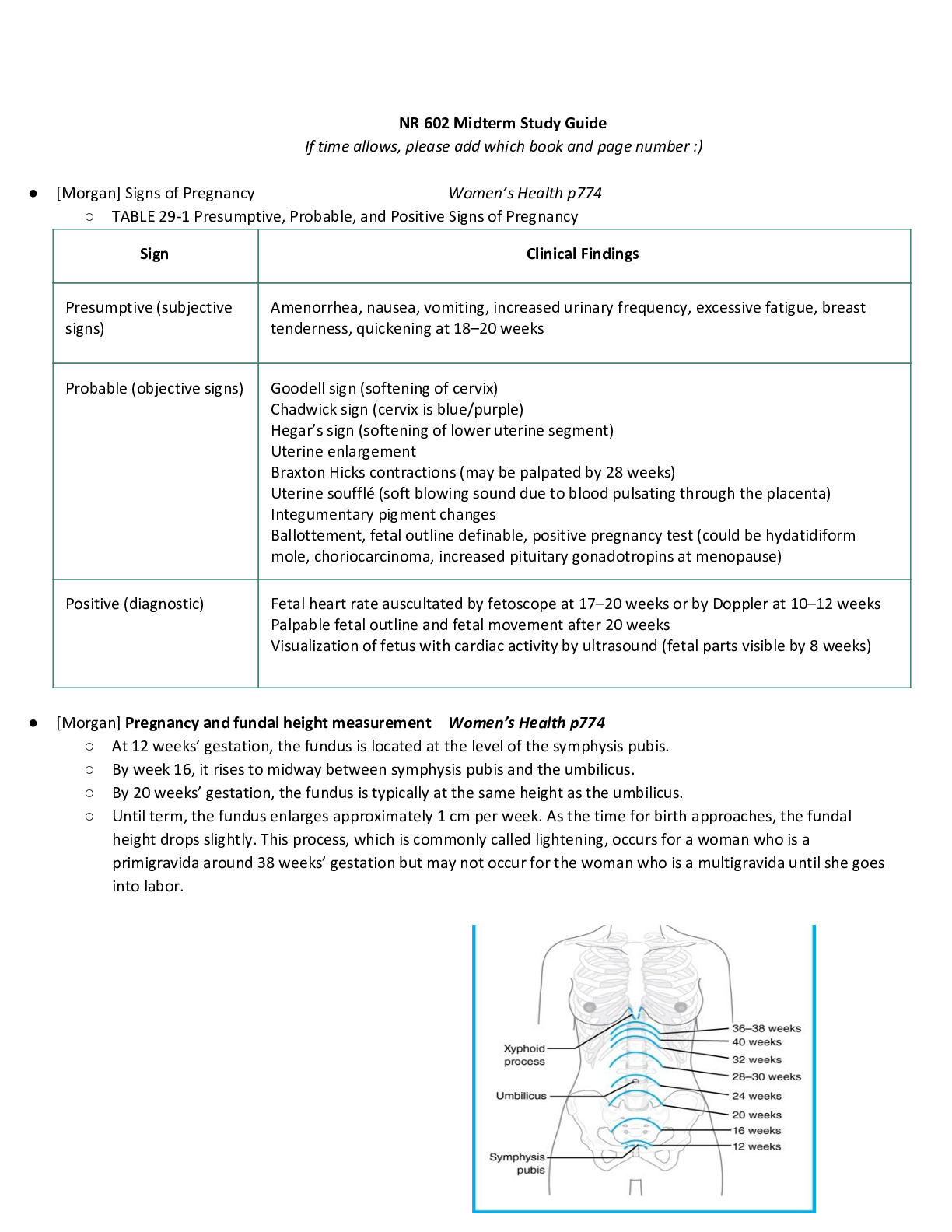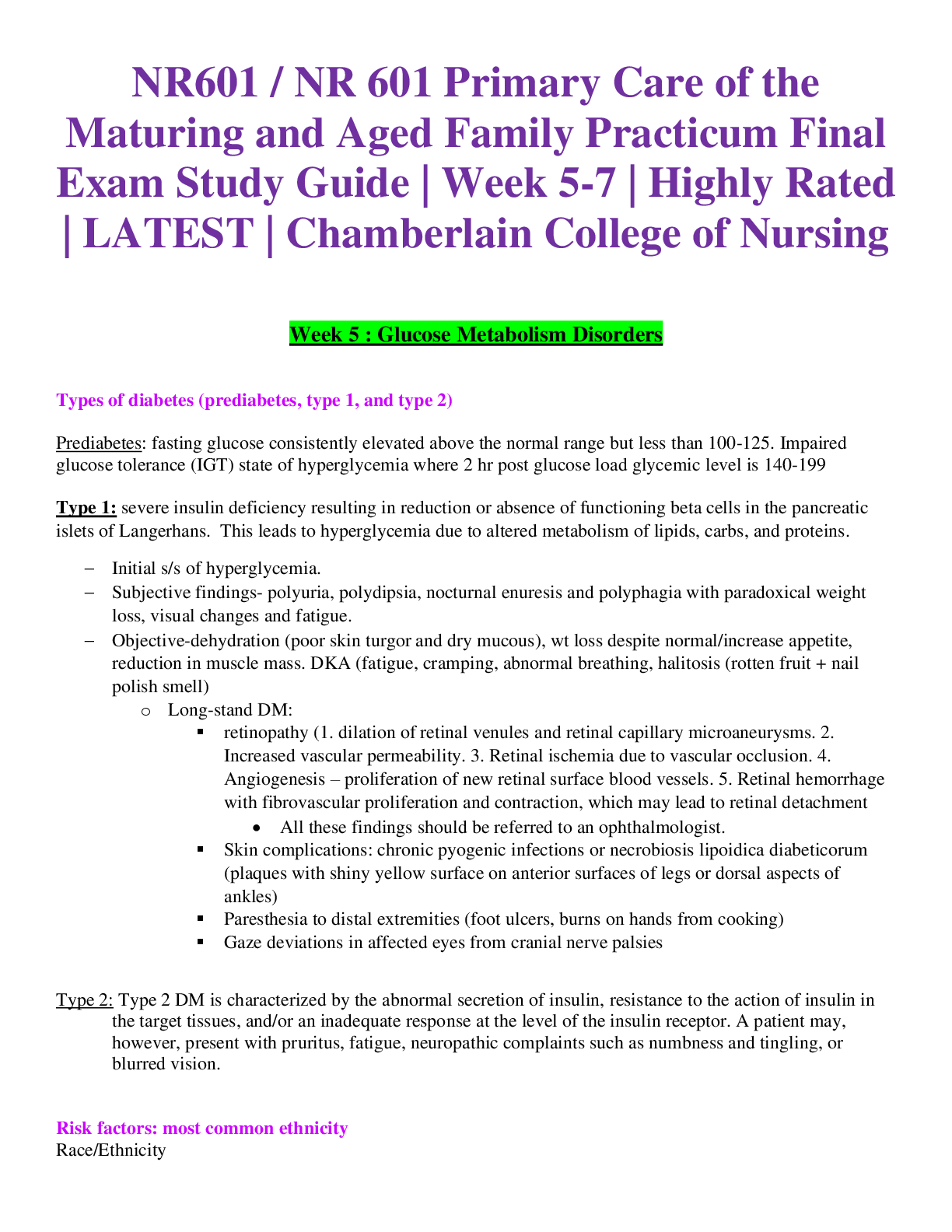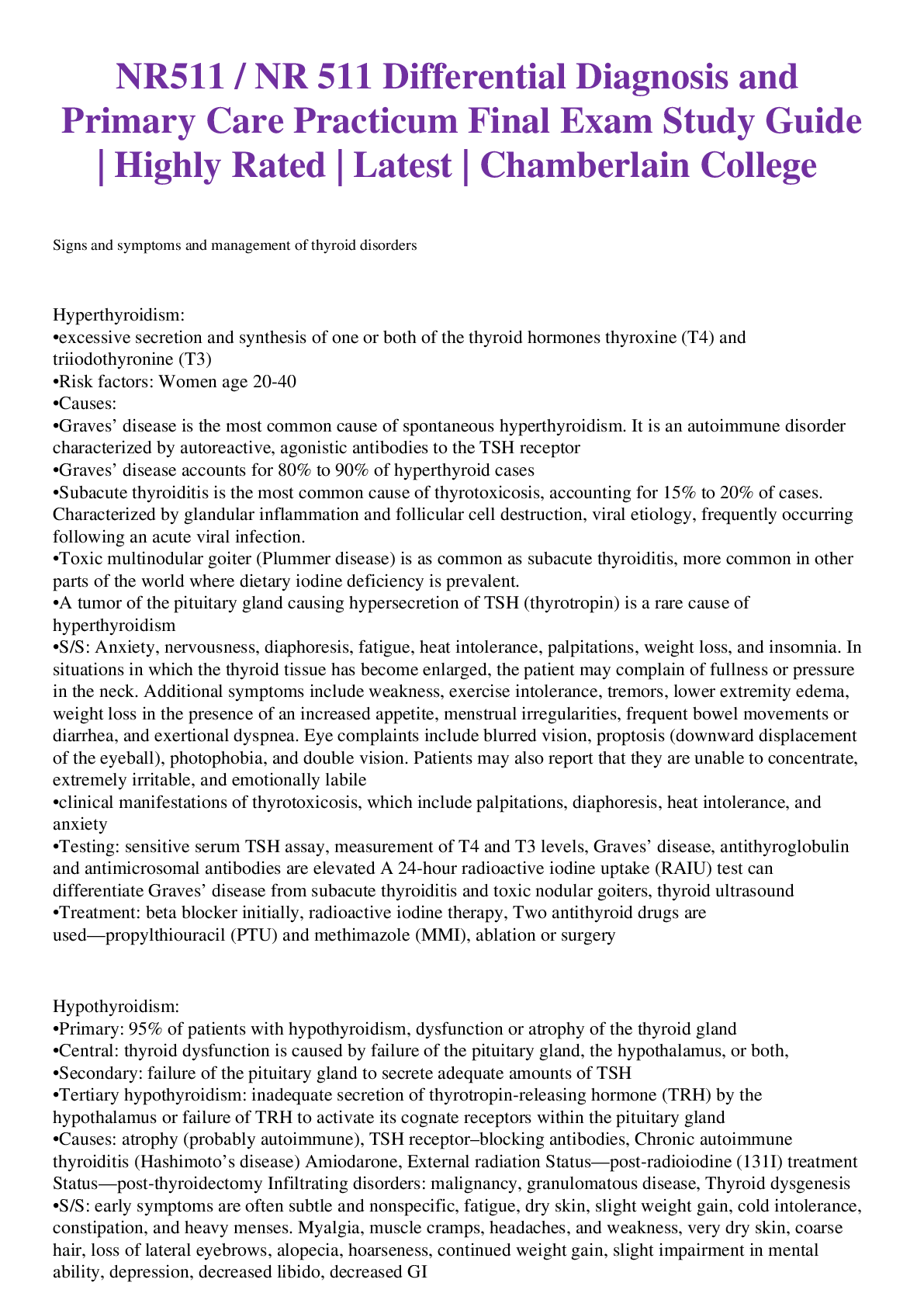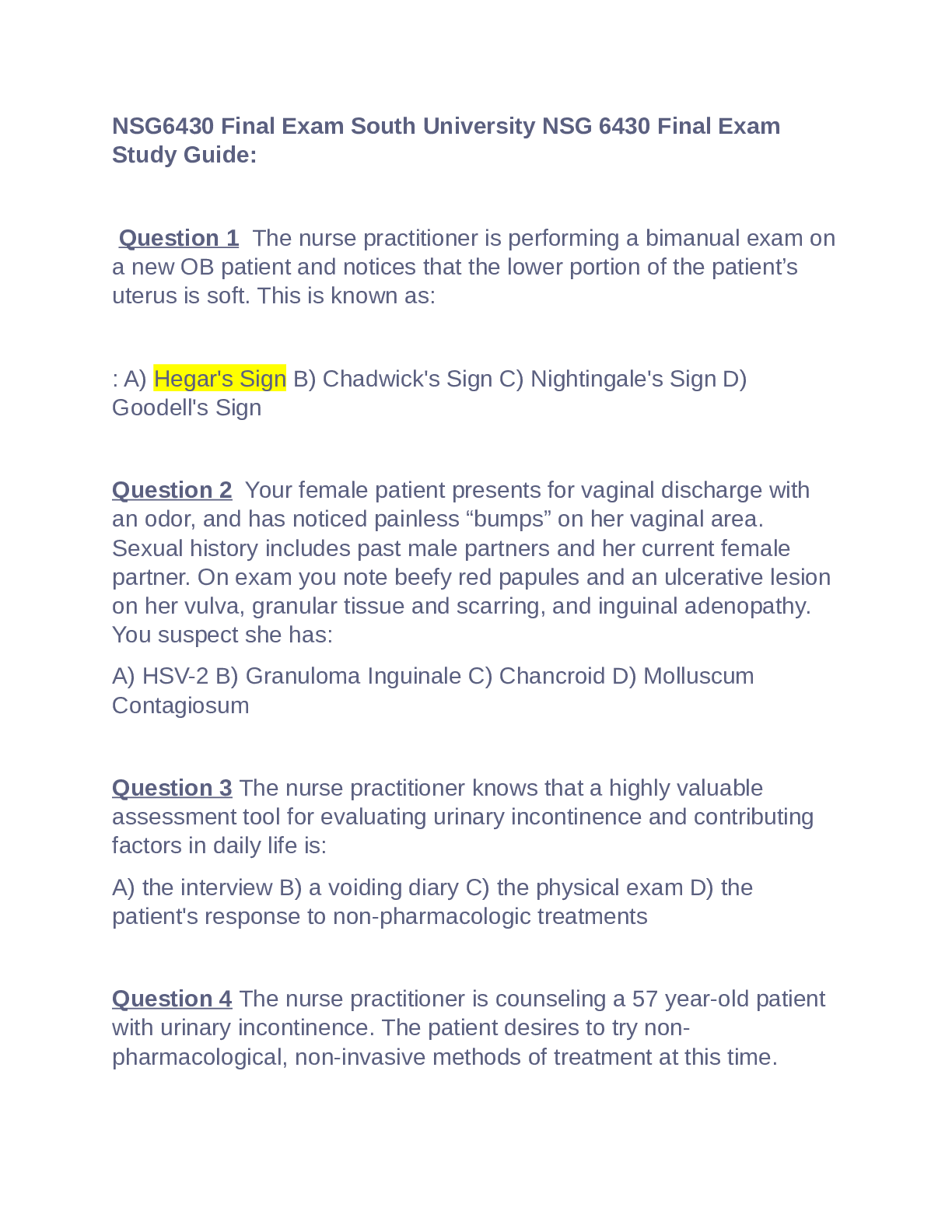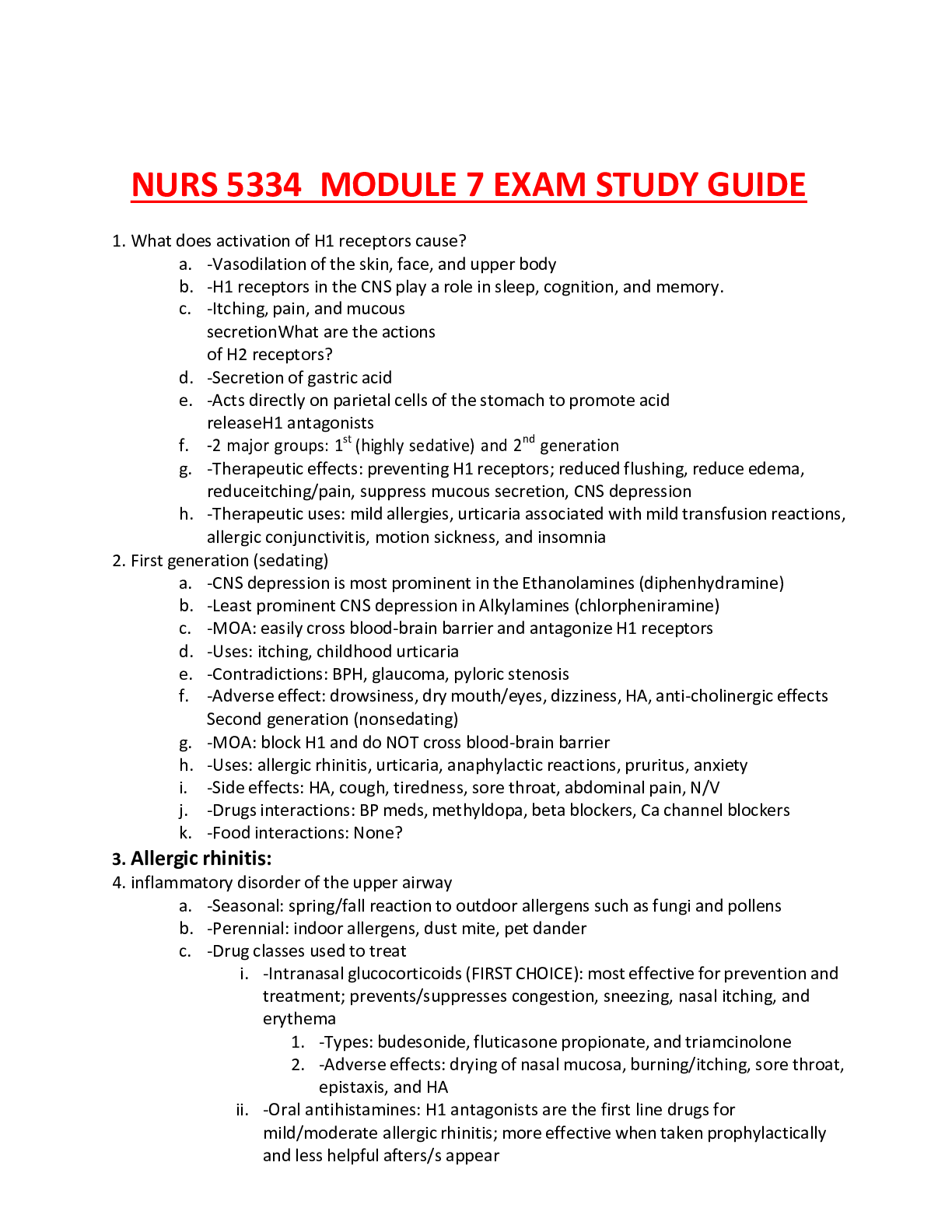*NURSING > STUDY GUIDE > NUR155 FINAL EXAM STUDY GUIDE – Galen College (All)
NUR155 FINAL EXAM STUDY GUIDE – Galen College
Document Content and Description Below
NUR155 FINAL EXAM STUDY GUIDE – Galen College NUR 155 FINAL EXAM STUDY GUIDE Health Promotion- promoting good health. Patient isn’t sick. It’s a way of thinking and it a positive approach... to wellness Health protection- patient is already sick. Point is to stop potential health occurrence or insults to health Maslow’s hierarchy of needs- used to prioritize nursing diagnosis. ABCs most important is physiological needs. levels of prevention: Primary prevention-focus on health promotion, protection against disease, precedes disease, applied to generally healthy individual or groups (immunization, nutrition, stress management, exercise, poison control, injury prevention) Secondary prevention-early detection of disease, intervention and health maintenance. (screening, dental checkups, self examinations, nursing assessments and care provided) Tertiary prevention- begins after illness, when defect or disability is fixed, or stabilized. Restore to optimum level of functioning (support groups, teaching to identify or prevent complications, physical or occupational therapy) Infection control safety precautions: - Standard Precautions- all patients, hand hygiene, gloves (mask, eye, and gown if splash or spray), needles in sharps, handle soiled linens, equipment that is soiled - Contact precautions- step up plus mask and private room (c-diff, MRSA, shingles, hepatitis) - Droplet- major difference, wear mask limit movement of patient, private room, mask patient if moved- pneumonia, flu - Airborne- N95 respiratory and AAIR room, TB - Mixed precautions – private room Nosocomial infections- Are classified as infections that originate in hospital. Develop during stay or manifest after discharge. (HAIs) subgroup health-care associated infections. (CLBSI-central line blood stream infection and CAUTI- catheter associated urinary tract infection) - Inadequate hand hygiene, improper dressing change, contamination of drainage system, improper catheterization, improper IV, tubing, site care and suctioning. Vital signs Body temperature, pulse, respiration and blood pressure, 5th one pain. How often we assess vital signs, chiefly nursing judgments, depending on patient’s health status or primary health care provider specific order. • Body Temperature (98.6-99.5 normal adults)- reflects balance between heat produced and heat lost from body. Core temperature- deep tissue. Surface Temperature- skin or subcutaneous. • Factors affect heat production: Basal metabolic rate, muscle activity, thyroxin output increase), Epinephrine and sympathetic stress response(increase)Fever (increase). 1. Age- infants are greatly influenced must be protected from extreme change. Older adults 75 and up high risk of hypothermia (loss of fat, lack of activity, inadequate diet) 2. Circadian Rhythms- Diurnal. Lowest point is during sleep 4am-6am and highest 4pm-6pm 3. Exercise- increase body temperature 4. Hormones- women usually fluctuate more than men because of progesterone. 5. Stress- sympathetic nervous system production of epinephrine or norepinephrine increase metabolic and heat production 6. Environment- outside temperature or room temperature. Regulation of body Temperature- 1. Shivering increases heat production 2. Sweating is inhibited to decrease heat loss 3. Vasoconstriction decreases heat loss Pyrexia- body above usual range • Pyrexia, hyperthermia in lay terms means Fever. • Febrile has fever, Afebrile one with out fever. Intervention: Monitor vitals, assess skin color and temp, monitor white blood count, dehydration, remove excess blankets, nutrition, fluids, measure input/output, dry clothing, tepid sponge bath, oral hygiene to keep mucous moist, reduce physical activity, administer antipyretics (meds that reduce level of fever). Sites used for body Temperature: • Oral- never after oral surgery, inaccurate if client just drank, ate or smoked • Rectal- Core, very accurate, never after rectal surgery or diarrhea, hemorrhoids, immune suppressed, clotting disorder. No longer used on in infants. • Axillary- leave longer • Tympanic- Core, fast right and left can differ presence of cerumen can affect reading • Temporal- electronic variation in technique if perspiration Types of fever: • Intermittent- regular intervals between fever • Remittent- stays high • Relapsing- short febrile and days between • Constant- not much variation • Fever spike- really high then gone fast Hypothermia- heat lost, below normal limits *Can be delegated to UAP but monitored by Nurse Pulse- output of blood that enter the arteries with each ventricular contraction • Compliance- arteries ability to contract and expand • Cardiac output- stroke volume multiplied by heart rate. • Peripheral pulse- located away from heart • Apical Pulse- located on apex of hear 5th intercostal space mitral, PMI Factors affecting Pulse • Age- decreases with age (newborn is high) • Sex- males lower • Exercise- increase with activity, rate of professional athlete is less then average person, greater cardiac strength • Fever- increase/ response to lowered blood pressure from vasodilation associated elevated body temp, increased metabolic rate • Medication- some decrease and other increase • Hypovolemia/dehydration-loss of blood or fluid • Stress-sympathetic nervous system • Position- standing or sitting increase • Pathology- certain disease, impaired oxygenation, heart conditions Pulse sites • Temporal, Carotid (code), Brachial, Apical, Radial. Femoral(code pt), Popliteal, Posterior Tibial and Dorsalis pedis Average Pulse Respiration Newborn 130(80-180) 35(30-60) 1 year 120(80-140) 30(20-40) 5-8 100(75-120) 20(15-25) 10 70(50-90) 19(15-25) Teen 75(50-90) 18(15-20) Adult 80(60-100) 16(12-20) Older adult 70(60-100) 16(15-20) Assessing Pulse • Palpation (three middle fingers), Auscultation, Doppler Rate and Rhythm • Tachycardia-fast, Bradycardia-slow, Arrhythmia- irregular *Can be delegated to UAP but monitored by nurse, not apical pulse Respirations- act of breathing. Inhalation intake of air Exhalation movement of gases from lungs. Ventilation movement of air in and out of lungs • Costal breathing- thoracic • Diaphragmatic- abdominal Assessing Respiration • Patient should be relaxed, be aware of normal breathing, medication that influence or health conditions • Rate (Bradypnea or Tachypnea) rhythm, quality, effectiveness of respiration (apnea- absence of breathing) • Hypo and hyperventilation Factors affecting respiration • Exercise, Stress • Increased environmental temperature • Elevation/altitude • Decreased temperature • Medications • Increased intracranial pressure (ICP) Breathing Patterns Rhythm- Cheyne-strokes waxing and waning very deep to very shallow. • Dyspnea- labored or difficult to breath • Orthopnea- ability to breathe only upright sitting or standing Breath Sounds- Normal • Vesicular- soft-intensity, low pitched, gentle sighing, smaller airways (bronchioles and alveoli) • Broncho vesicular- moderate-intensity pitched blowing sounds larger airways(bronchi) • Bronchial(tubular)- high pitched loud harsh sounds moving through trachea. Adventitious Breath Sounds • Crackles(rales)- fine, short, crackling. Air passing through fluid or mucus. • Gurgles(rhonchi)- low-pitched, coarse, gurgling, moaning, snoring. Best heard on expiration. Narrow passages as result of secretions, swelling or tumors. • Wheeze- high pitched, squeaky musical sounds best heard on expiration. Air passing through constricted bronchus, secretions, swelling or tumors • Friction rub- superficial grating or creaking sounds. Inflamed pleural surface *Cannot be delegated to UAP Blood Pressure Systolic- the pressure of blood as result of contraction of the ventricles (height of blood wave) Diastolic- pressure when ventricles are at rest(low) Pulse pressure- is the difference between the diastolic and systolic pressure (normal pulse pressure 40 and can be is high as 100 during exercise) Measured in millimeters of mercury (mmHg) *Normal blood pressure 120/80, prehypertension (120-139/80-89), hypertension stage 1 (140-159/90-99), stage 2 (160-100)- Hypotension- (systolic 85-110) Factors affecting blood pressure • Age- newborns have lower 75 systolic pressure rises with age peak at onset of puberty then declines. Older adults’ elasticity of arteries decrease, this produces elevated systolic diastolic may be higher. • Exercise- increase • Stress- vasoconstriction increasing • Race- African American 35 have higher • Sex- after puberty females have lower • Medications- may increase or decrease • Obesity- hypertension • Diurnal variation- lowest morning, higher afternoon early evening • Medical conditions- • Temperature- increased metabolic rate, fever increase however external heat, vasodilation decreased, Cold- vasoconstriction elevates Assessing blood pressure- Sphygmomanometer, make sure cuff is the right size 40% of arm or 20% wider. Electronic devices. *Can be delegated to UAP *SBAR • S- situation- state your name, unit, patient name, briefly state problem • B- background- admission diagnoses, medical history, summary of TX to date, code status • A- assessment- vital signs, pain scale, change from prior assessment • R- recommendation- what you would like done, ask provider wants to order test or meds, if they want to be notified for any reason, no improvement when you should call. • I- introduction • 4 basic components: • Database: known when pt. 1st enters health care facility, nursing assessment, primary care history, social & family data, baseline physical exam & diagnostic test. • Problem list: derived from database. Caregivers contribute, physiological, psychological, social, cultural, spiritual, development, and environmental needs. Medical problems, diagnoses, surgical procedures, symptoms; nurse diagnoses. (ex impaired mobility, urinary incontinence). • Plan of Care- Initial list of orders or plan of care. • Progress notes- chart entry’s made by ALL Health care professionals involved in patient’s care. SOAP or SOAPIER- Subjective- obtained from client, Objective-information measured or observed (vital signs, lab, x-ray). Assessment- conclusions drawn subjective and objective from data (clients condition and level of progress). Plan- plan designed to resolve stated problem. I- intervention, E- evaluation, R- revision. Documenting and Reporting: Chart [Show More]
Last updated: 1 year ago
Preview 1 out of 39 pages

Reviews( 0 )
Document information
Connected school, study & course
About the document
Uploaded On
May 24, 2020
Number of pages
39
Written in
Additional information
This document has been written for:
Uploaded
May 24, 2020
Downloads
0
Views
272

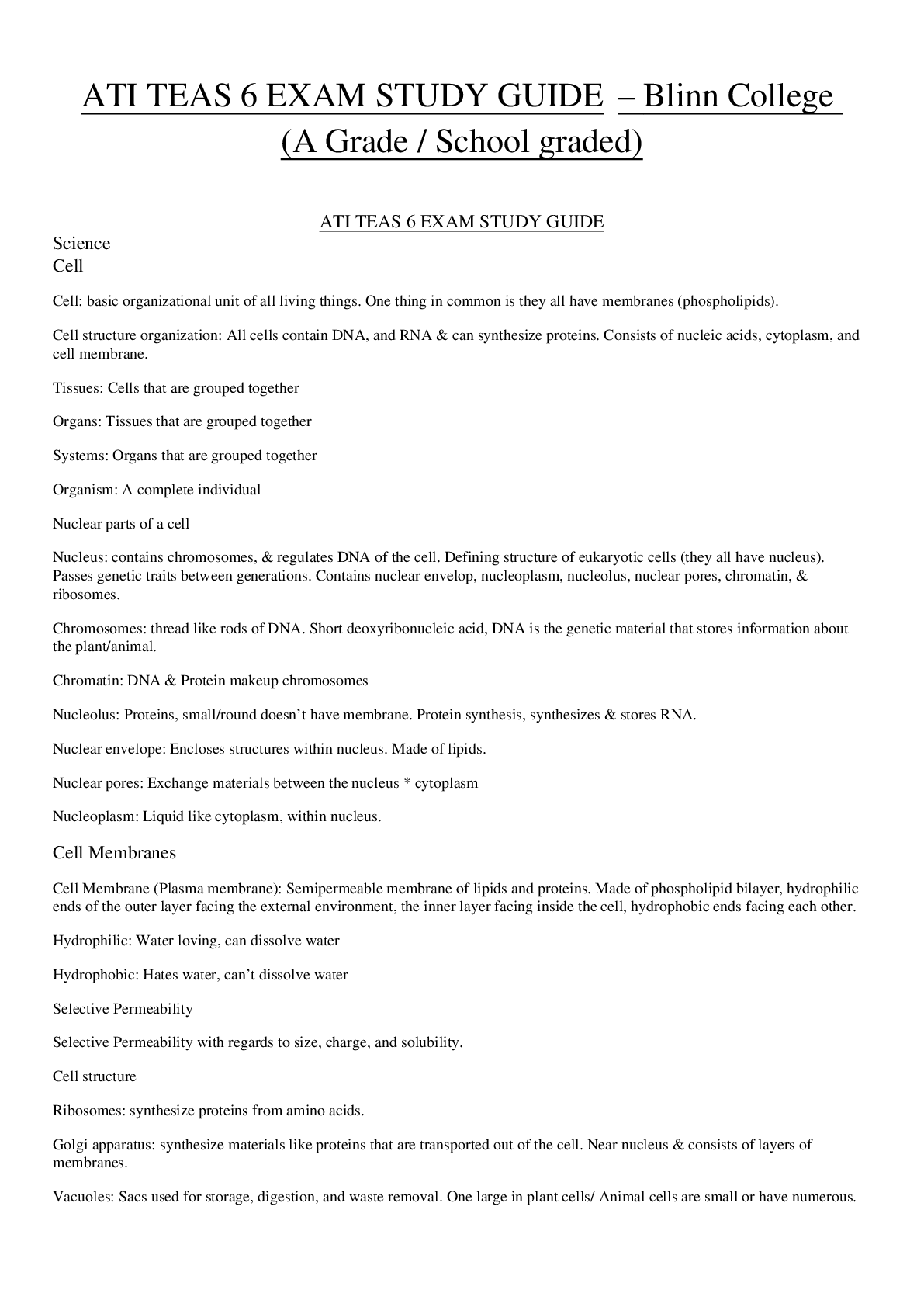
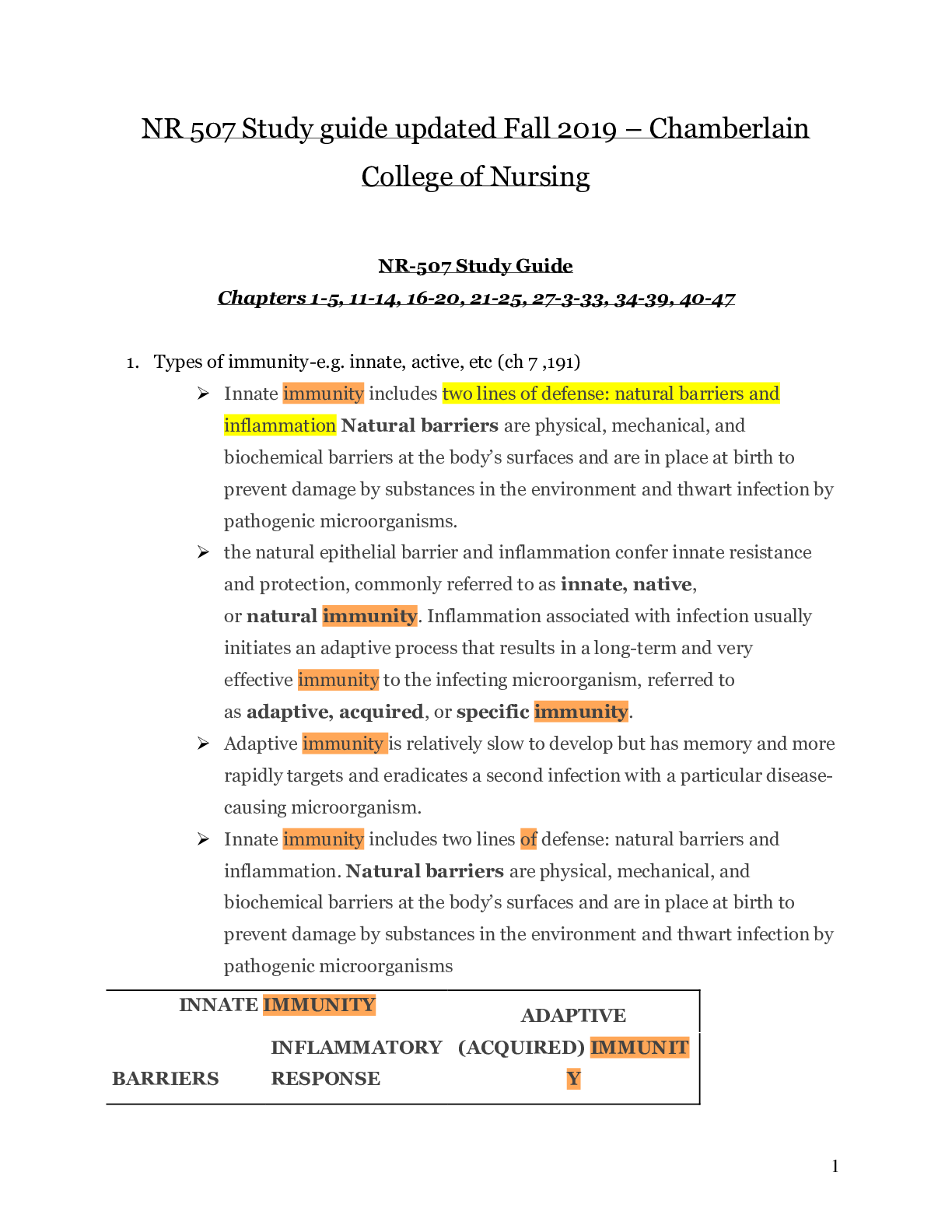
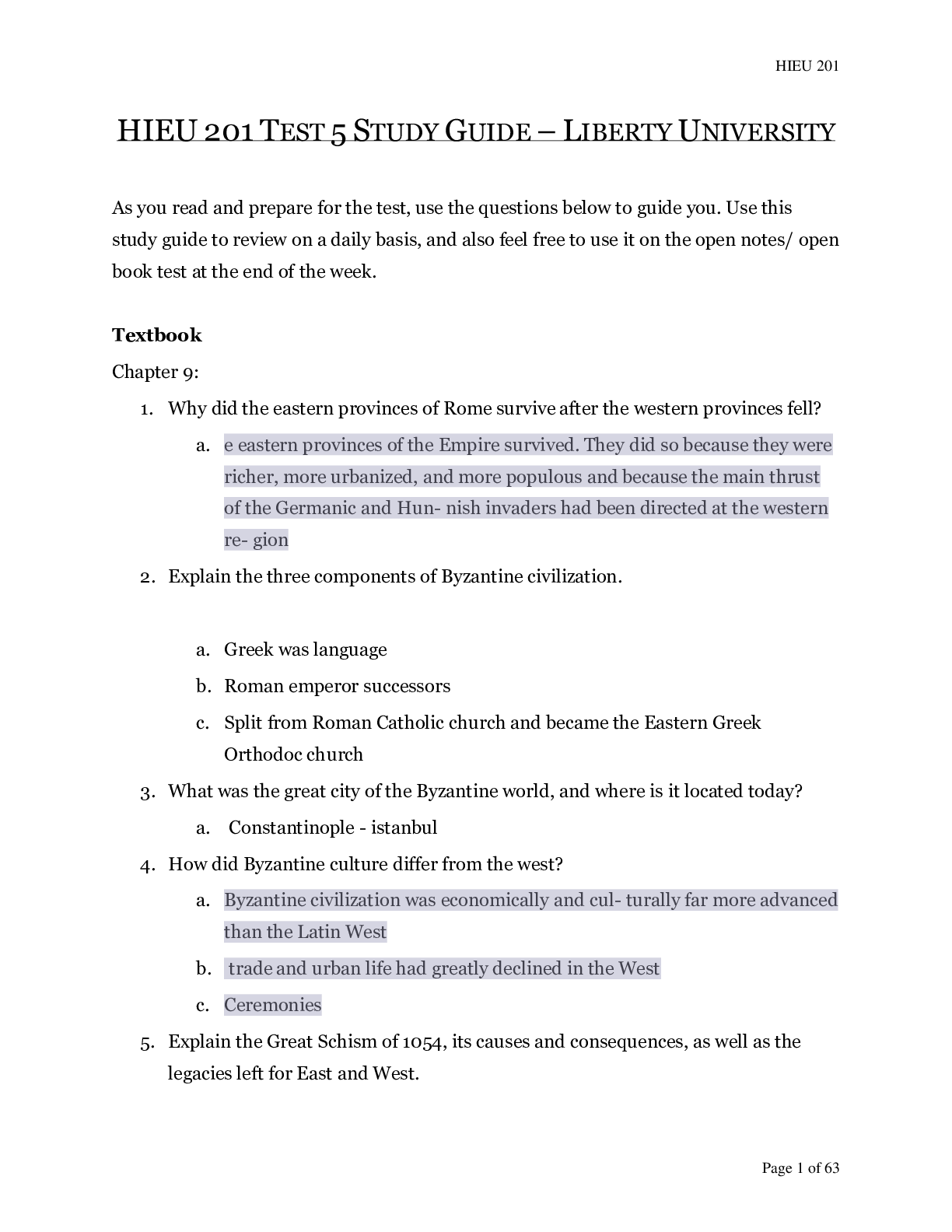
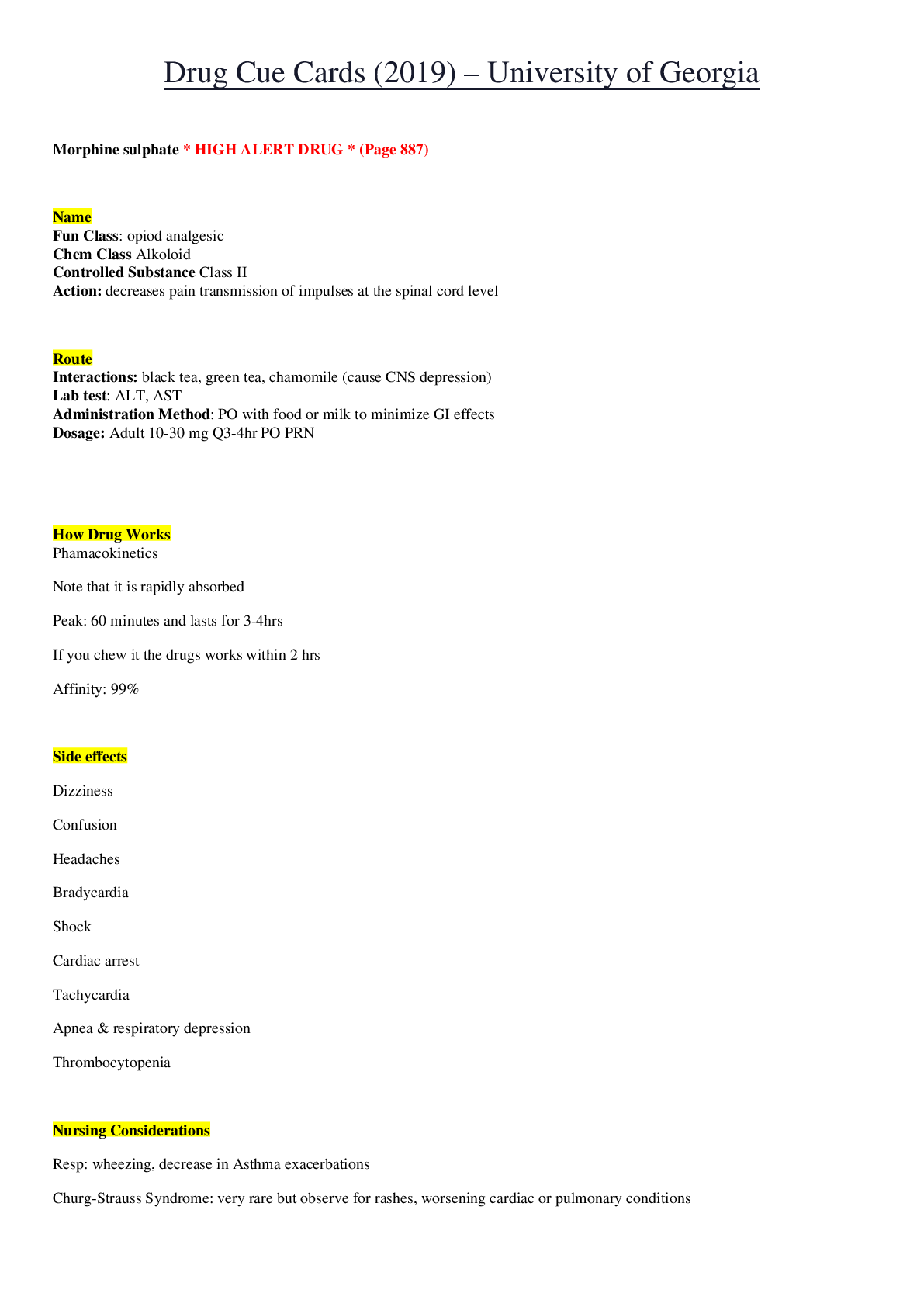
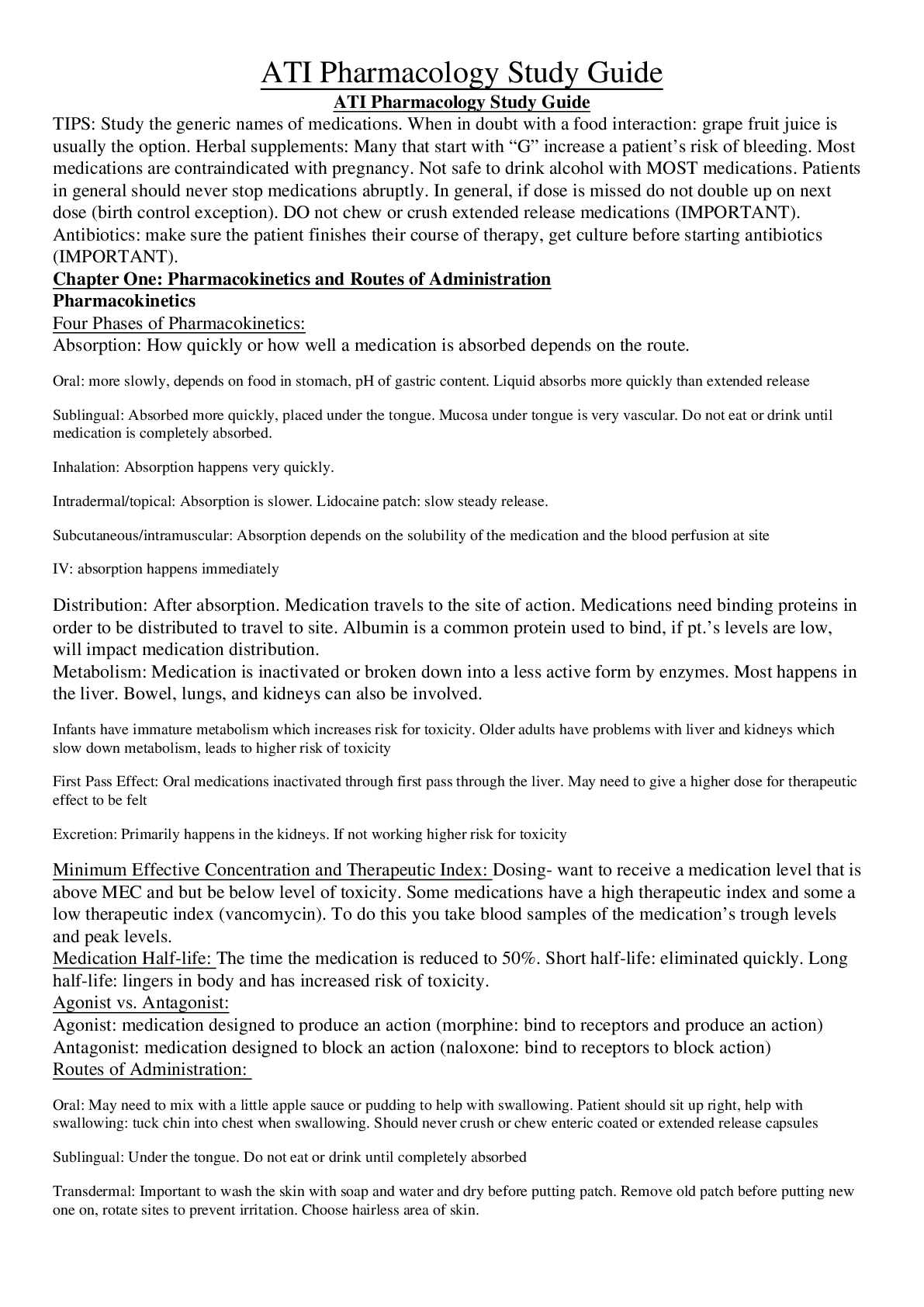
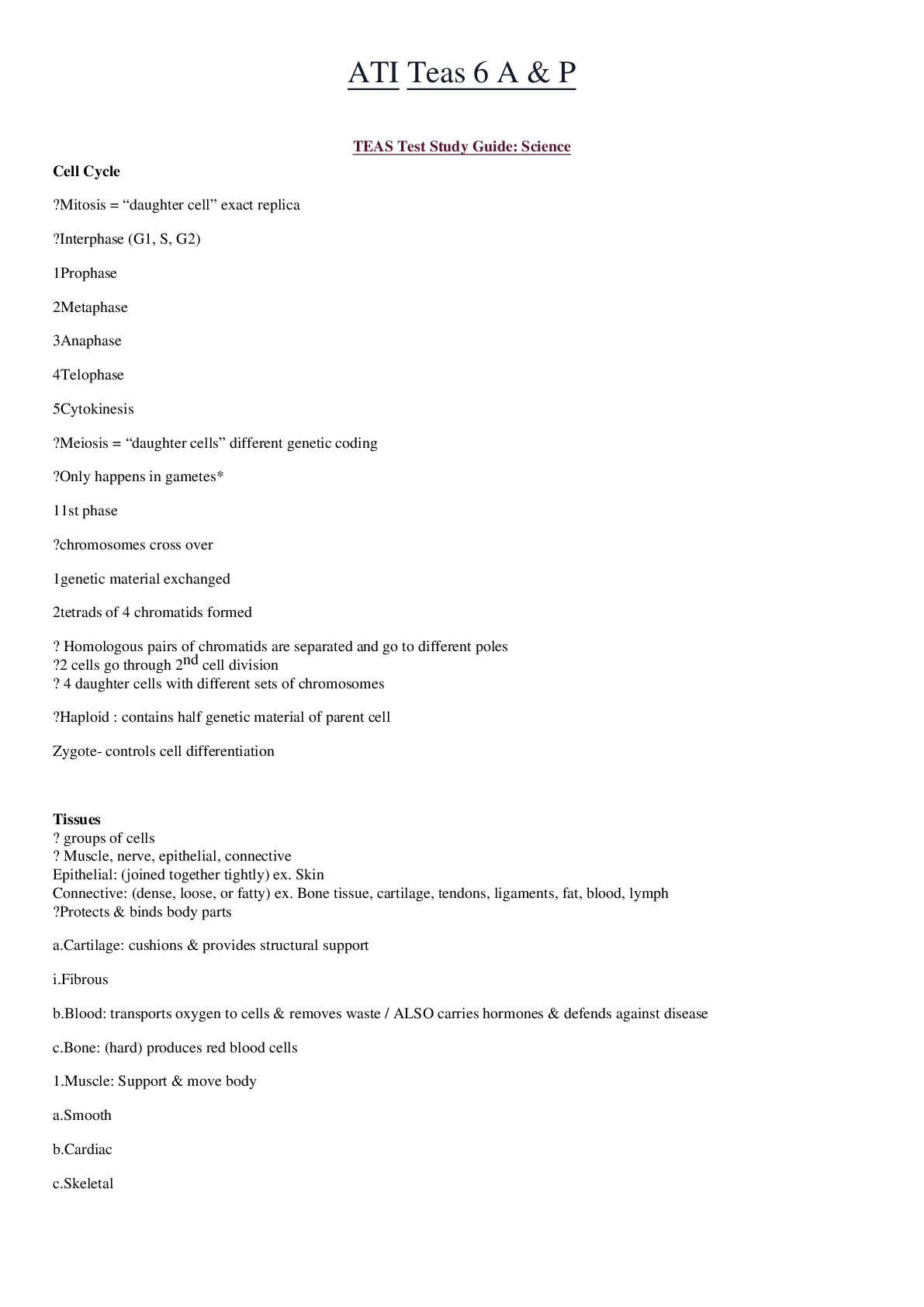
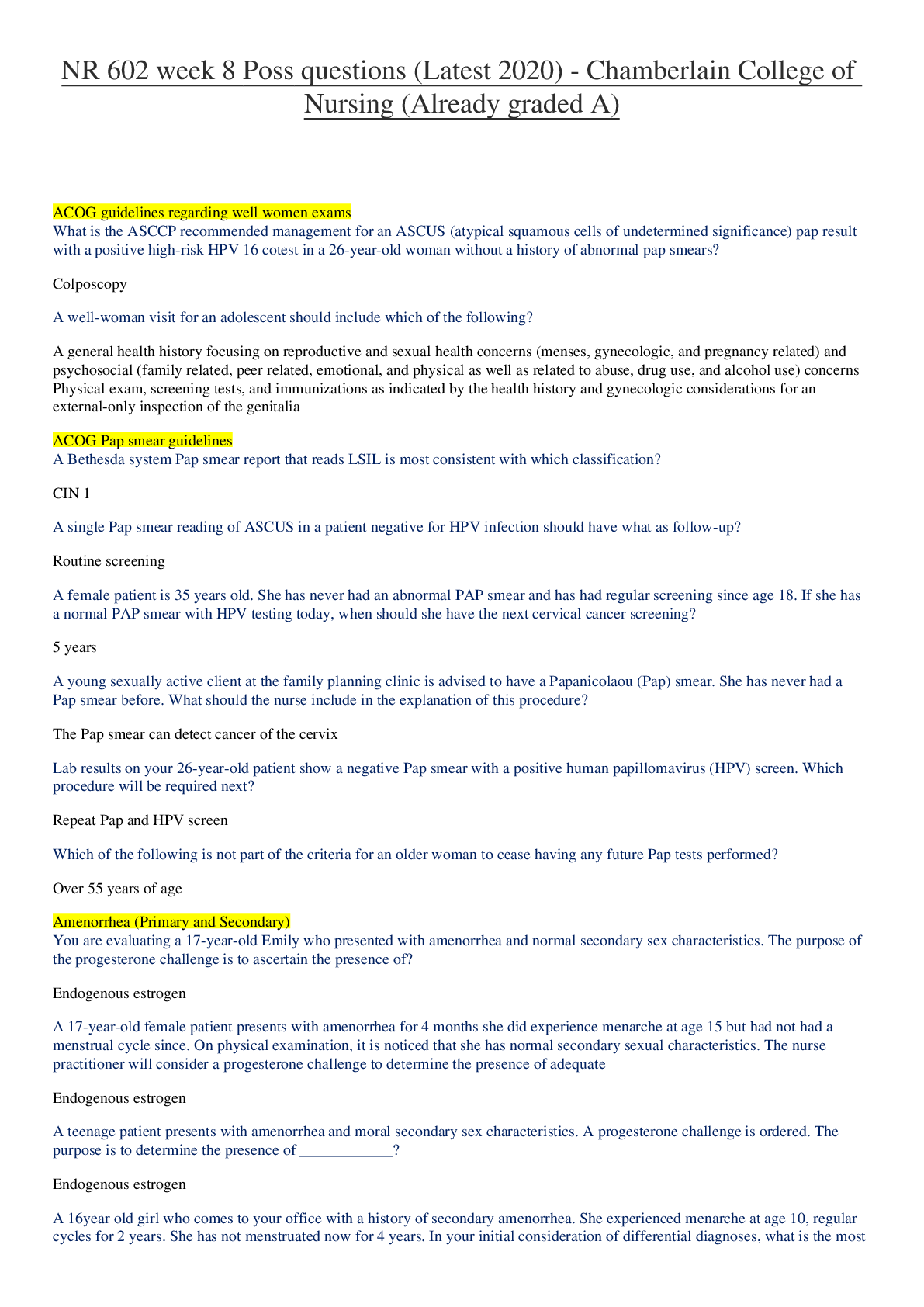
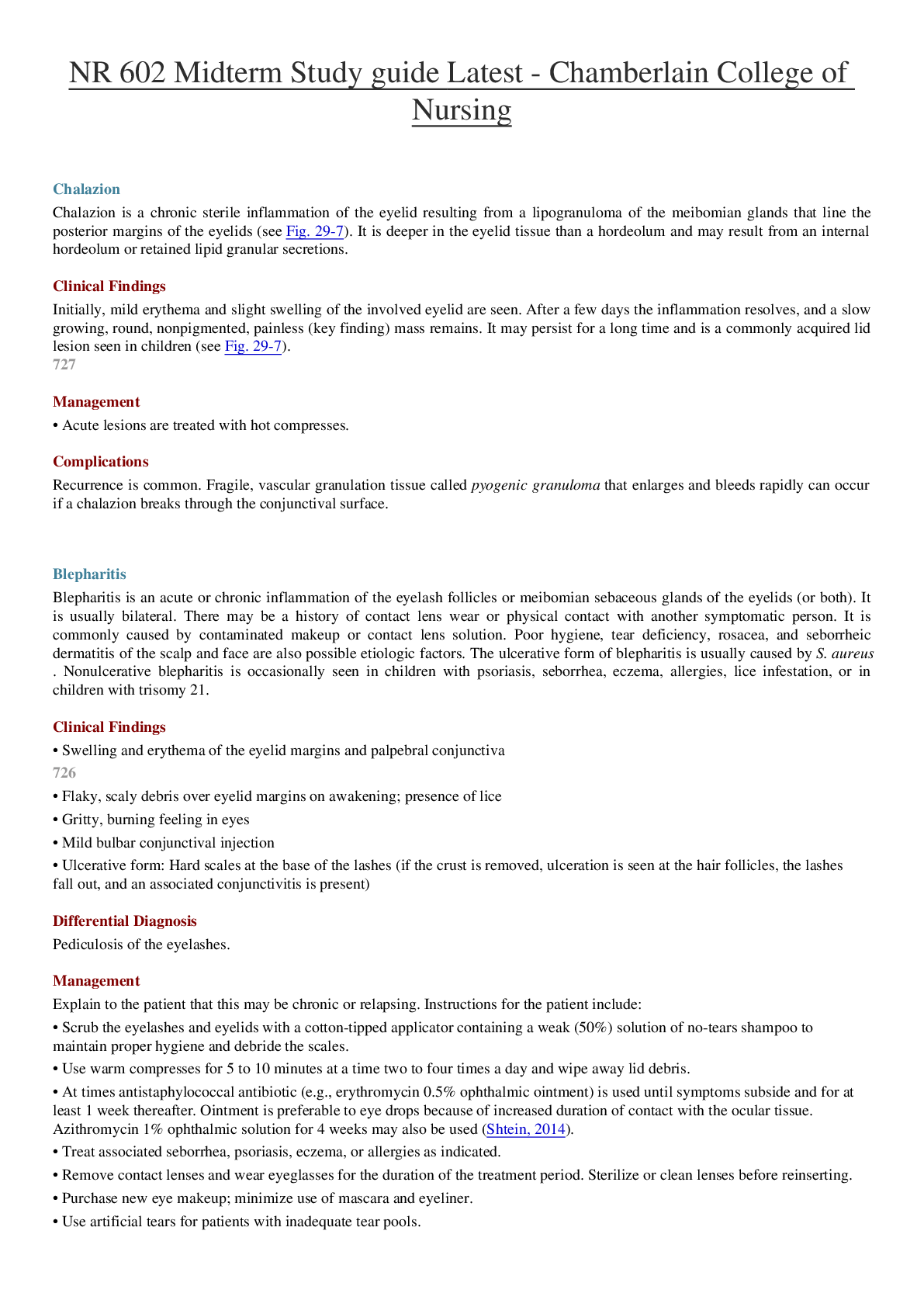
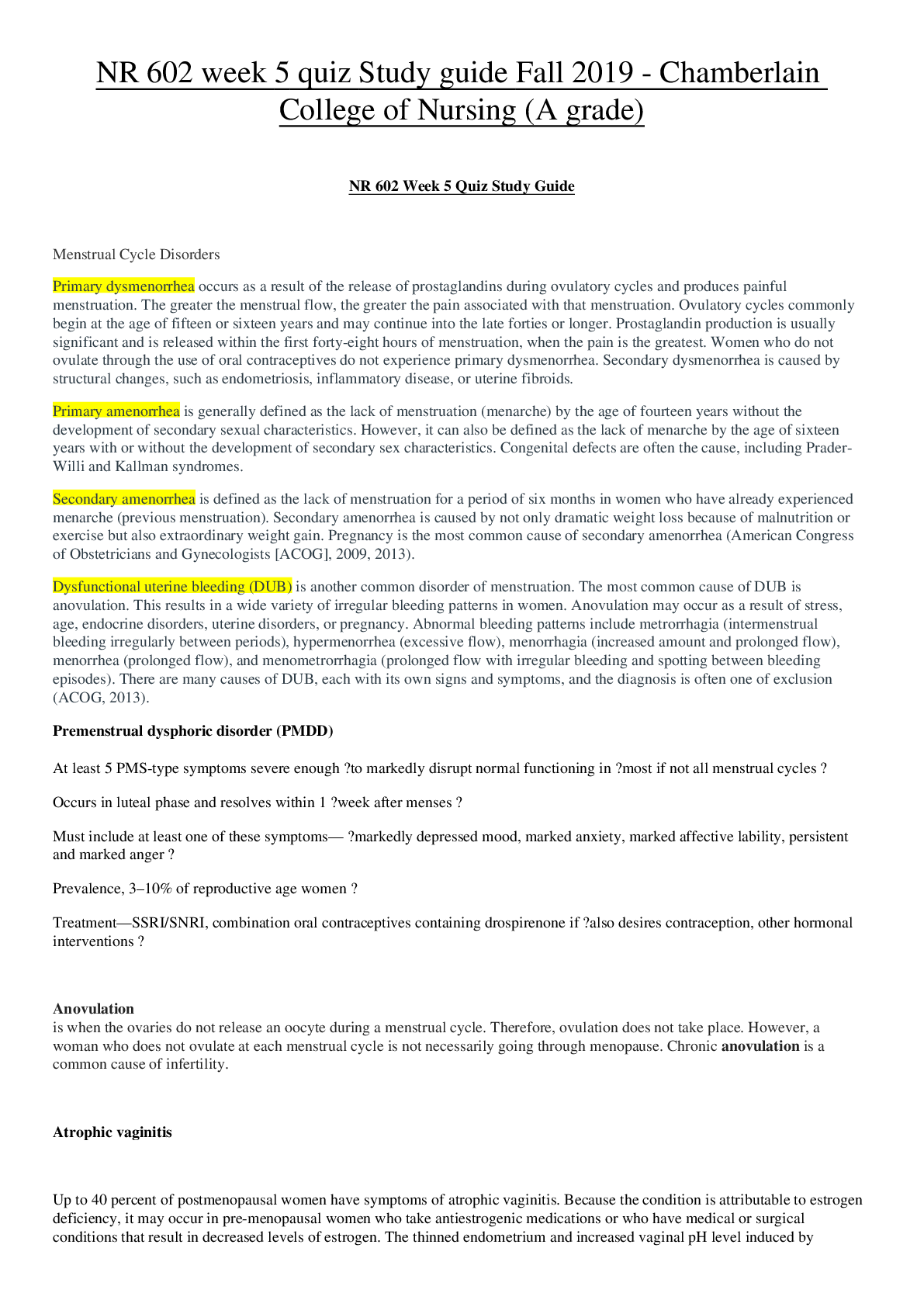
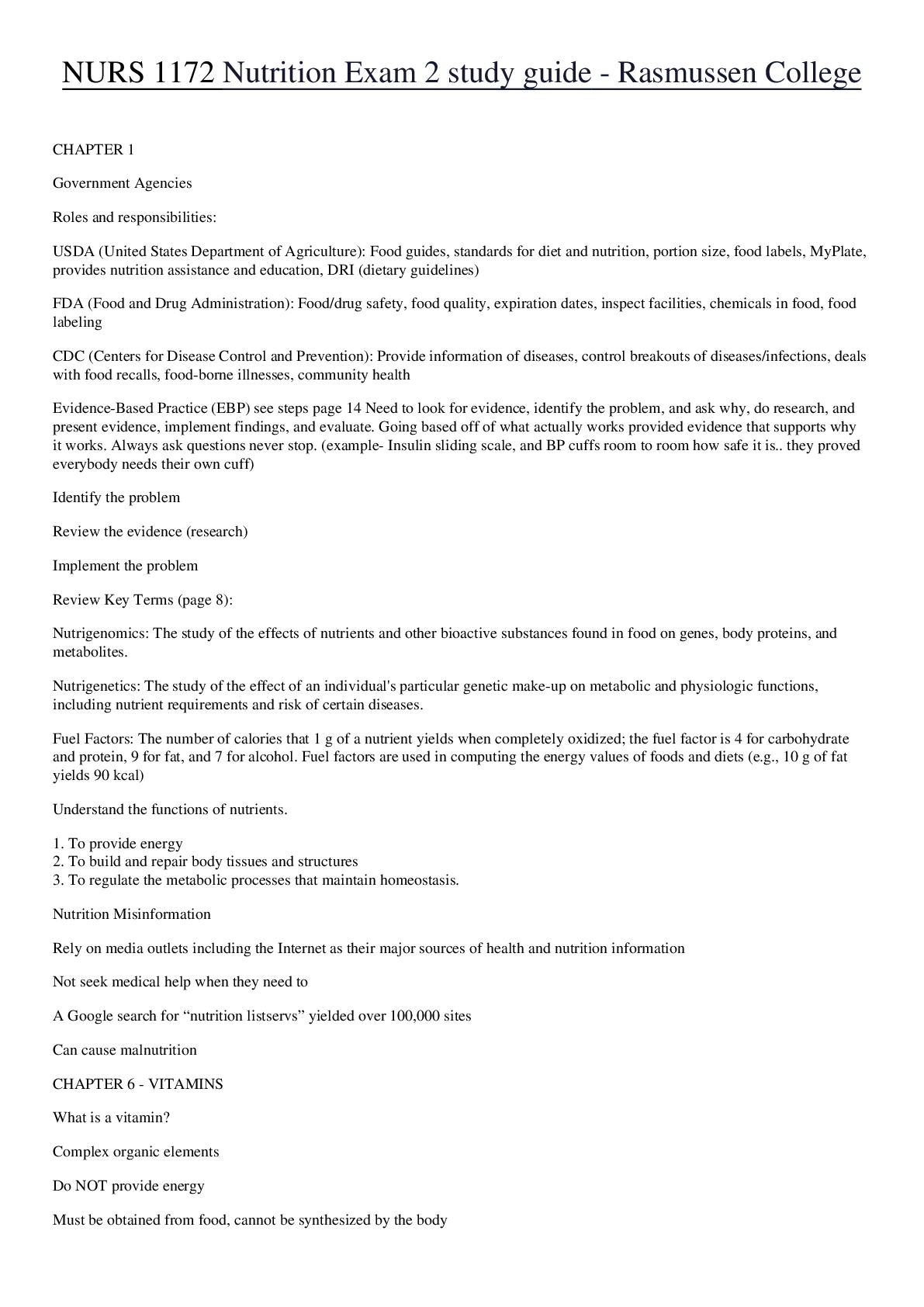
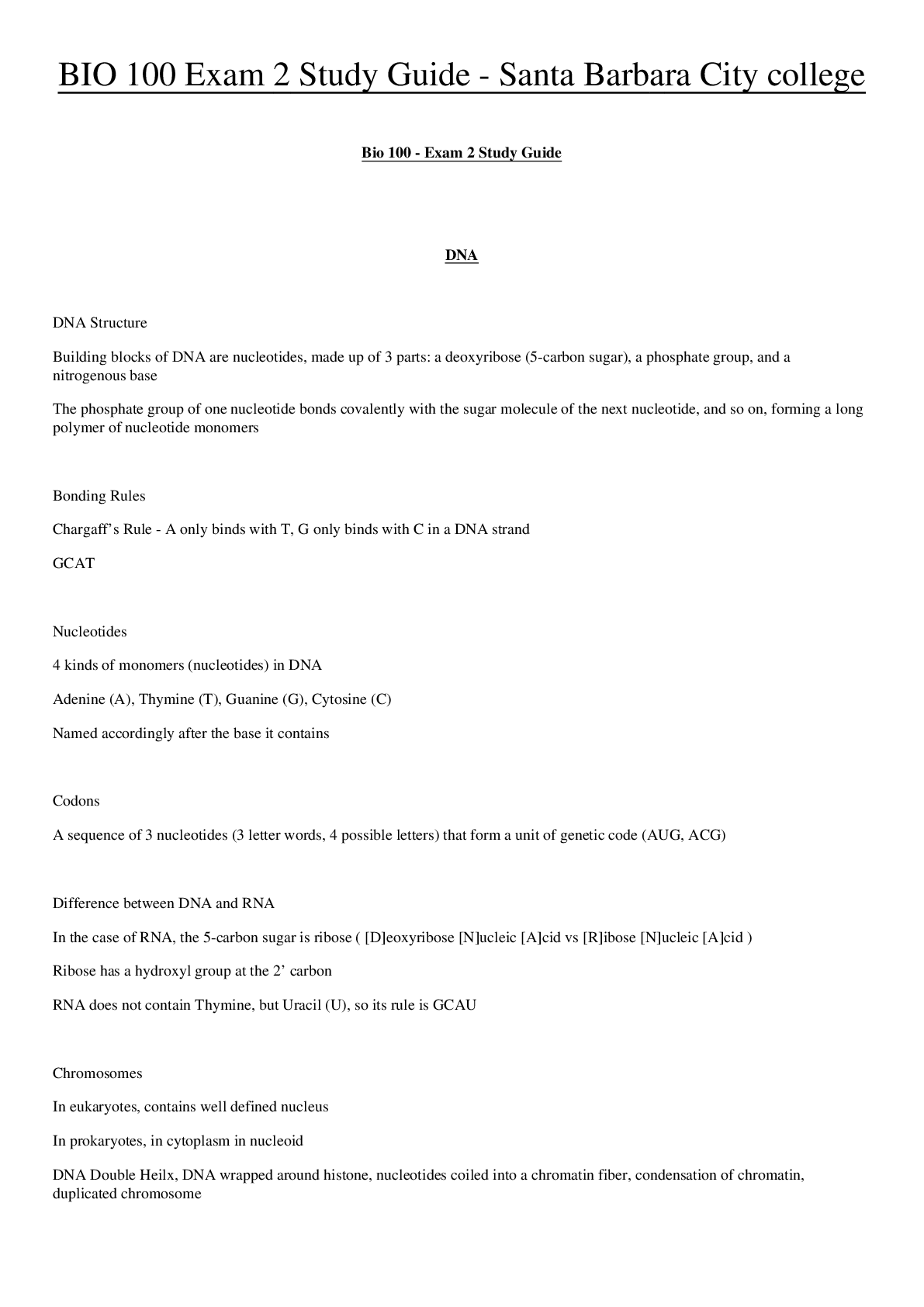
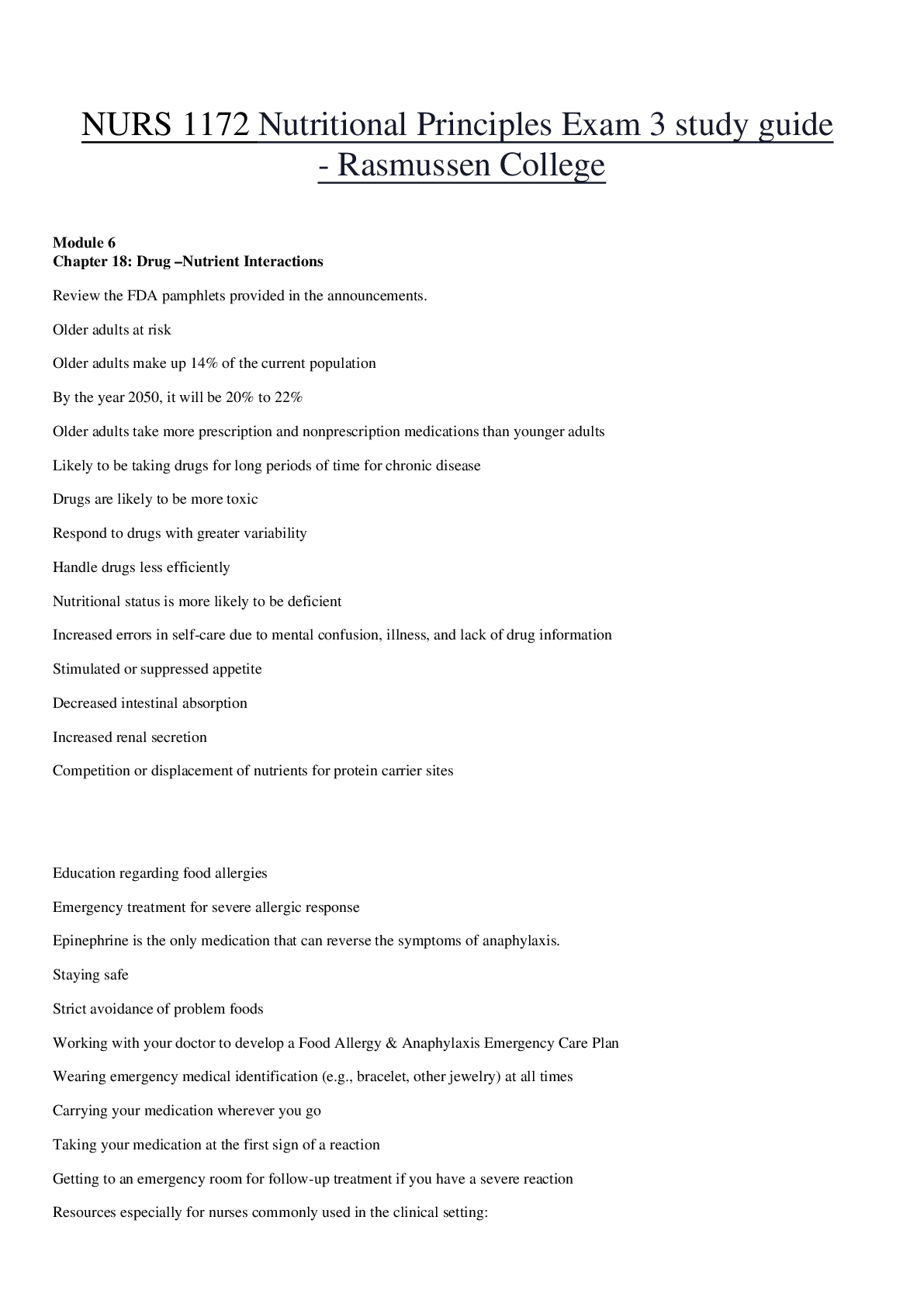
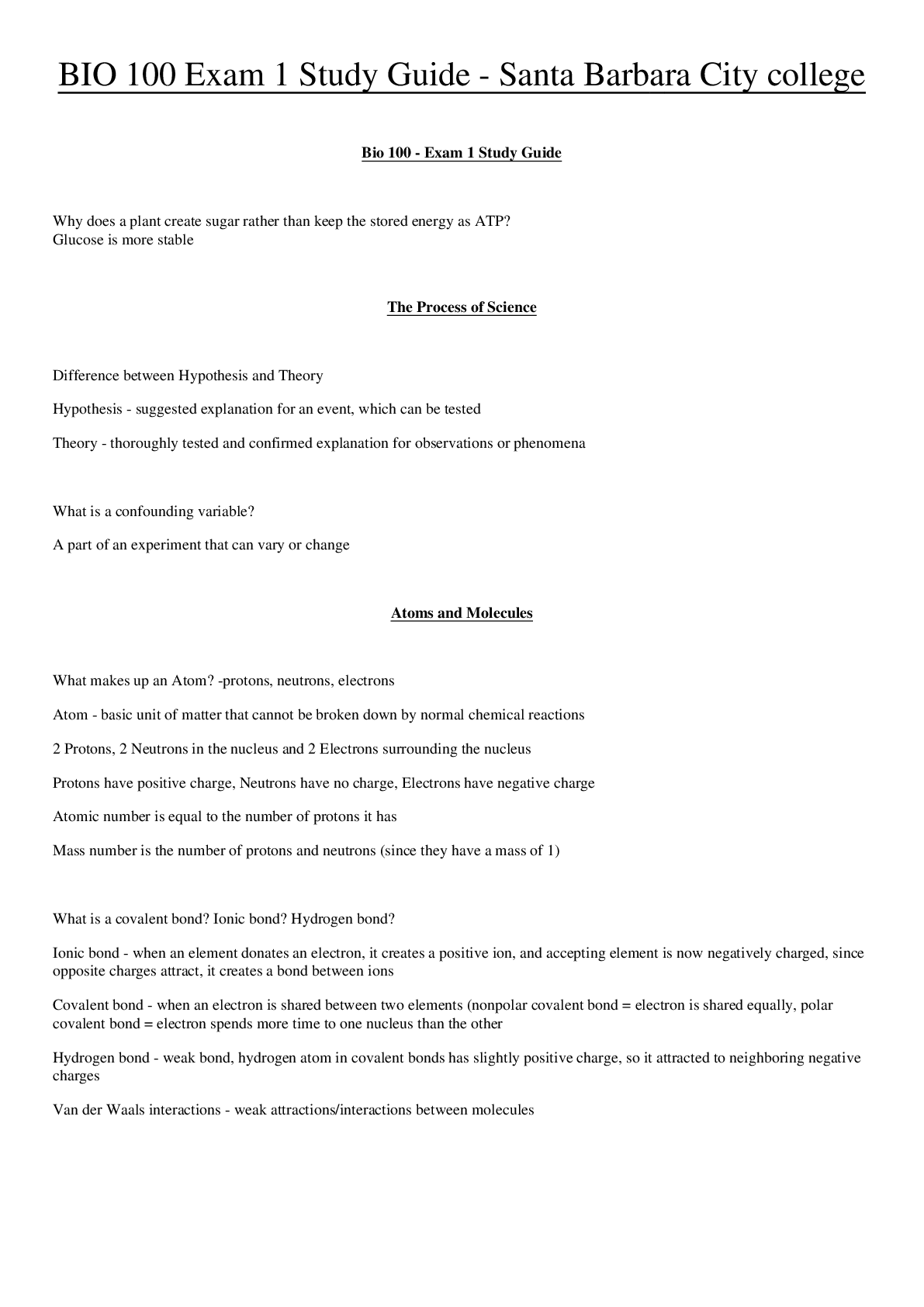
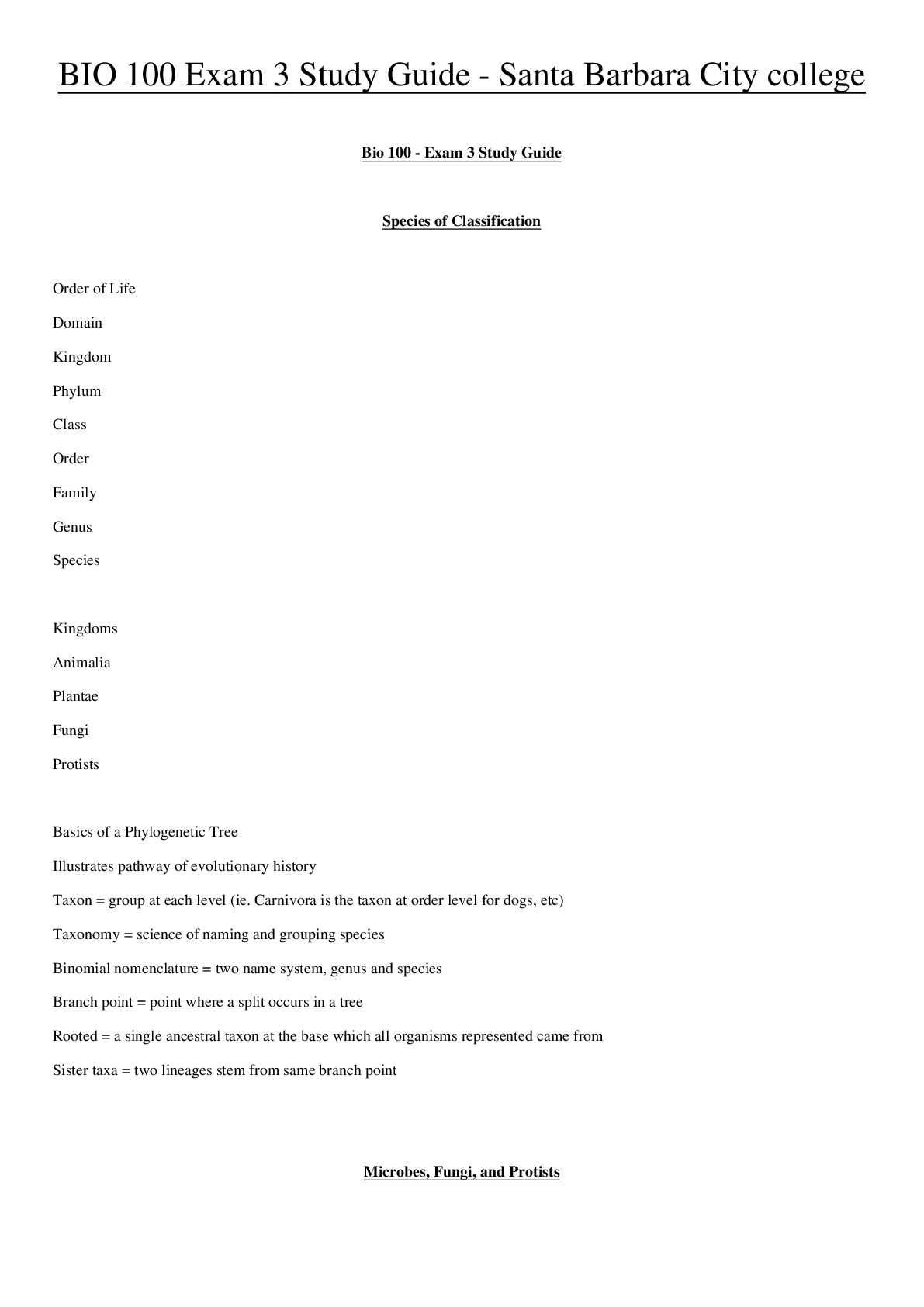
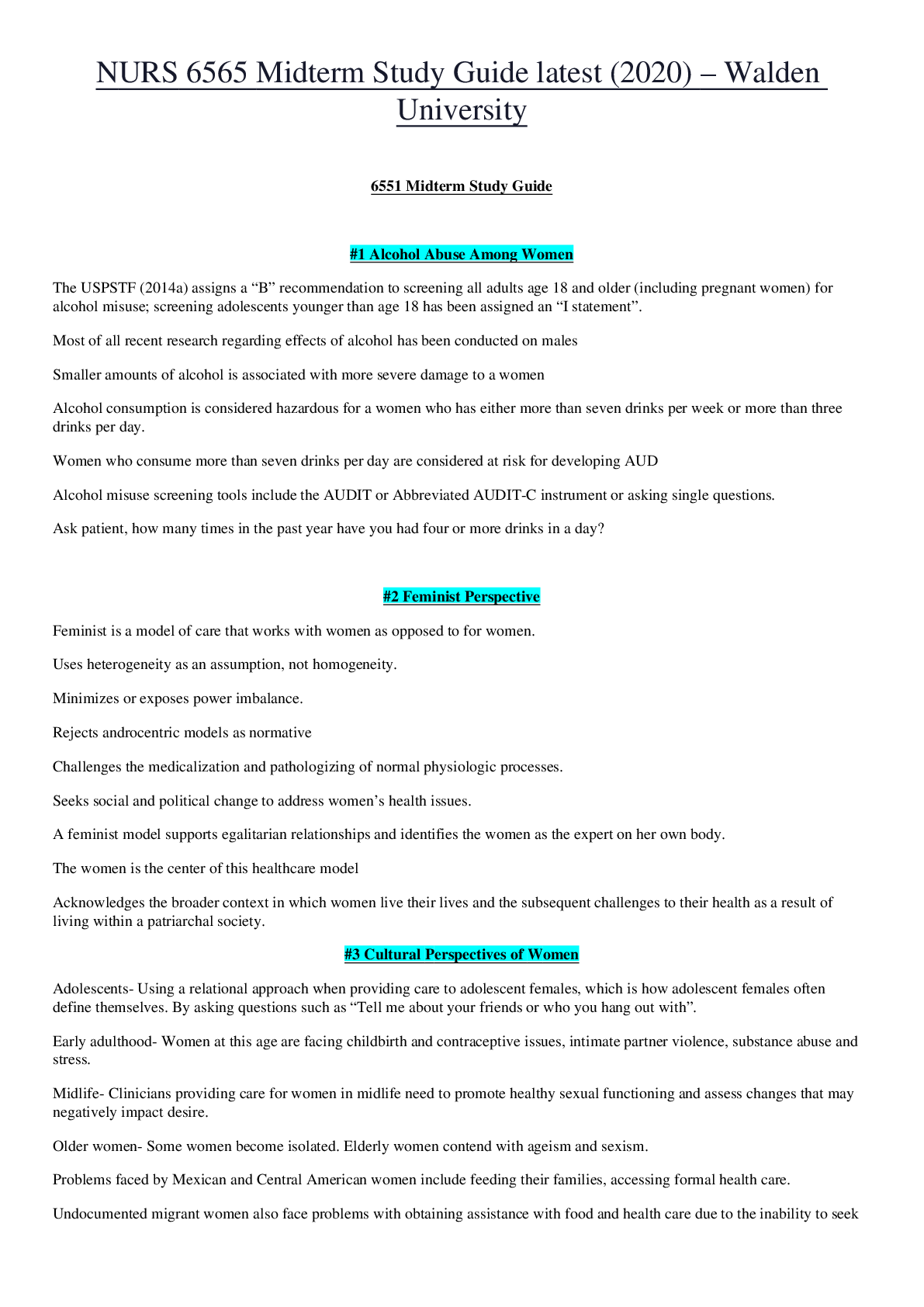





 Rasmussen College.png)
